As you consider bringing a dracaena plant into your home, you’re likely wondering how to care for it. With over 100 varieties, dracaena plants are a popular choice for indoor gardening due to their low-maintenance requirements and ability to thrive in a range of lighting conditions. To get started, it’s essential to understand the basics of dracaena plant care, including how to care for a dracaena plant and what to expect from your new houseplant.

Dracaena plants can grow to be between 4 and 10 feet tall, depending on the variety, and are known for their upright, straplike foliage that is either green or variegated. By following the right dracaena plant care tips, you can enjoy the many benefits of having a dracaena plant in your home, including improved air quality and a touch of natural beauty.
Table of Contents
Introduction to the Dracaena Plant
With over 100 species, the Dracaena plant is a versatile and attractive addition to any indoor space. You can find dracaena plant varieties that grow up to 10 feet tall, adding a touch of tropical elegance to your home or office. Dracaena plants are known to purify the air and improve indoor air quality, making them a great choice for indoor spaces.

Some of the benefits of having a Dracaena plant include its ability to remove toxins like benzene and formaldehyde from the air. The dracaena plant benefits also include its low-maintenance care, making it a great choice for busy people. However, it’s essential to keep in mind that Dracaena plants are toxic to dogs and cats, so it’s crucial to keep them out of reach of pets.
Overview of Dracaena Species
There are many different species of Dracaena plants, each with its unique characteristics. Some popular species include Dracaena fragrans, Dracaena surculosa, and Dracaena marginata. These plants can be categorized into two growth types: treelike and rhizomatous.
Benefits of Indoor Dracaena
In addition to their air-purifying properties, Dracaena plants can also help to improve the aesthetic of a room. With their sleek, slender leaves, they can add a touch of modern elegance to any space. Here are some benefits of having an indoor Dracaena plant:
- Improves indoor air quality
- Low-maintenance care
- Can grow up to 10 feet tall
- Comes in a variety of species
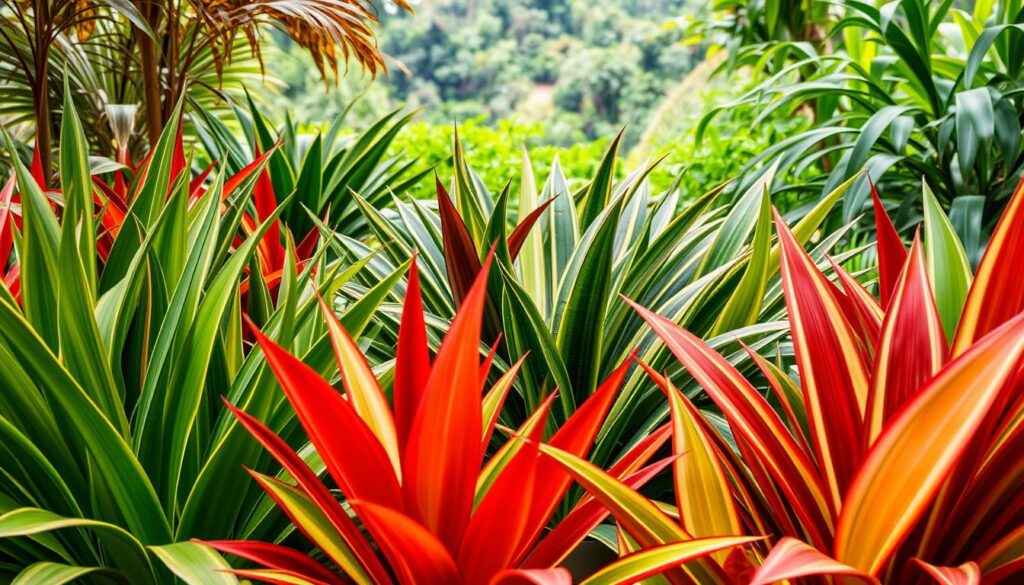
Overall, the Dracaena plant is a great choice for anyone looking to add some greenery to their indoor space. With its many benefits and low-maintenance care, it’s a great option for busy people or those new to plant care.
| Species | Height | Width |
|---|---|---|
| Dracaena fragrans | Up to 10 feet | 1-2 feet |
| Dracaena surculosa | Up to 8 feet | 1-2 feet |
| Dracaena marginata | Up to 6 feet | 1-2 feet |
Ideal Growing Conditions for Dracaena
To ensure your Dracaena plant thrives, it’s essential to provide it with the right growing conditions. When it comes to dracaena plant care, understanding the ideal environment is crucial. Dracaena plants prefer bright, indirect light but can tolerate low-light conditions. They thrive in temperatures between 65-75°F (18-24°C), making them perfect for indoor spaces.
For optimal how to care for dracaena plant, consider the following factors:
- Light Requirements: Dracaena can tolerate low light but thrives with at least 2 to 4 hours of bright indirect light daily.
- Temperature Preferences: Ideal daytime temperature range for Dracaena is 65-78 degrees F, with nighttime temperatures being 10 degrees cooler.
By providing your Dracaena plant with the right amount of light and maintaining a comfortable temperature, you’ll be well on your way to creating an optimal environment for your plant to grow and flourish. Remember, dracaena plant care is all about finding the right balance, and with these tips, you’ll be able to give your plant the best chance to thrive.
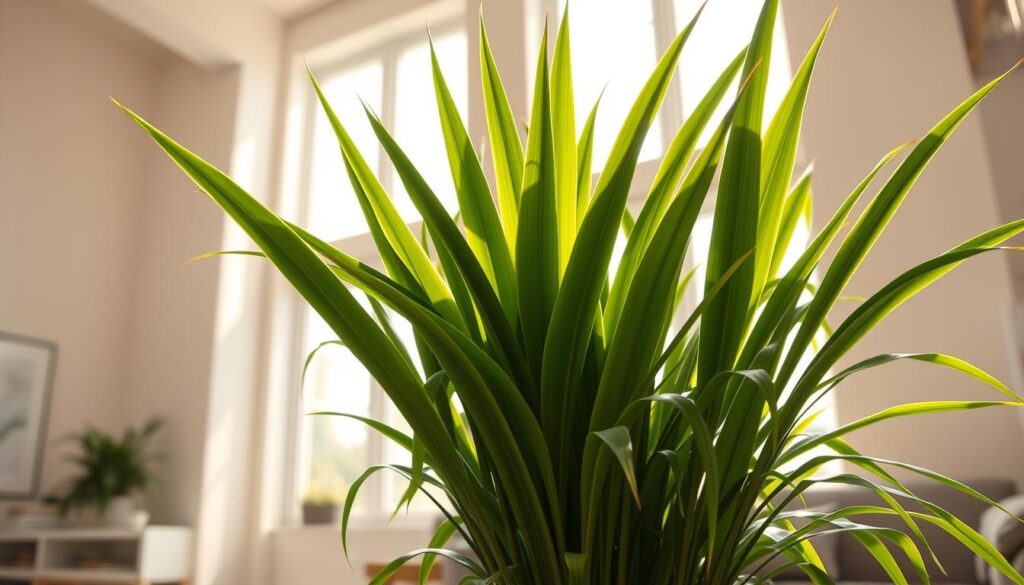
With proper how to care for dracaena plant, you can enjoy the many benefits of having a Dracaena plant in your home, from air purification to aesthetic appeal. By following these guidelines and providing your plant with the right growing conditions, you’ll be able to keep your Dracaena happy and healthy for years to come.
Choosing the Right Pot for Dracaena
When it comes to dracaena plant care, selecting the right pot is crucial for the plant’s growth and development. The pot should be slightly larger than the plant’s root ball, allowing for proper drainage and aeration. Dracaena plant potting requires a pot with good drainage holes to prevent water from pooling, which can lead to root rot.
A suitable pot size for a dracaena plant can vary, but a general rule of thumb is to choose a pot that is about 1-2 inches larger in diameter than the current root ball. This allows for adequate room for the roots to grow without becoming too pot-bound. It’s also essential to consider the material of the pot, as some materials, such as terracotta, may require more frequent watering due to their ability to dry out quickly.
Some key considerations for dracaena plant potting include:
- Choosing a pot with good drainage holes to prevent water from pooling
- Selecting a pot that is slightly larger than the plant’s root ball
- Considering the material of the pot and its potential impact on watering frequency
By selecting the right pot for your dracaena plant, you can help ensure it receives the right amount of water and nutrients, leading to healthy growth and development. Remember to repot your dracaena every 3-5 years to provide fresh soil and a larger pot if necessary, and to monitor your plant’s condition to determine the best potting strategy for its specific needs.
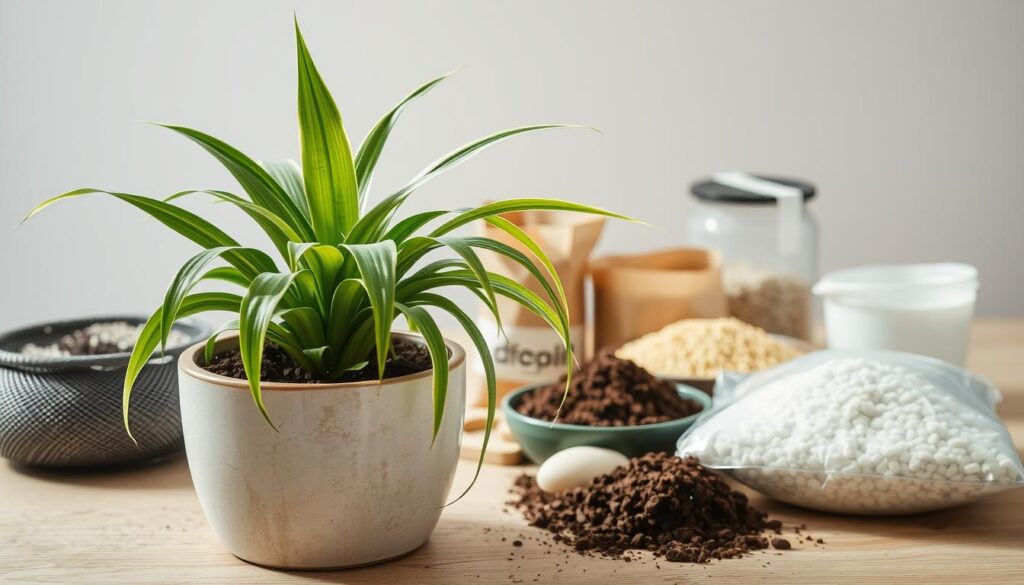
Best Soil Mix for Dracaena
When it comes to creating the ideal environment for your dracaena plant, the soil mix plays a crucial role. A well-draining soil mix is essential to prevent waterlogged soil, which can lead to root rot and other problems. The right dracaena plant soil should have a pH between 6.0-7.0, making it slightly acidic to neutral.
To achieve this, you can mix 1 part loam, 1 part pumice or perlite, and 1 part peat moss or pine fines. This combination provides excellent drainage while maintaining moisture levels. Dracaena plant fertilization can also be optimized with the right soil mix, as it allows for better nutrient uptake.
Some key characteristics of a good dracaena plant soil mix include:
- Good drainage to prevent waterlogging
- A slightly acidic to neutral pH (6.0-7.0)
- Ability to retain moisture without causing waterlogging
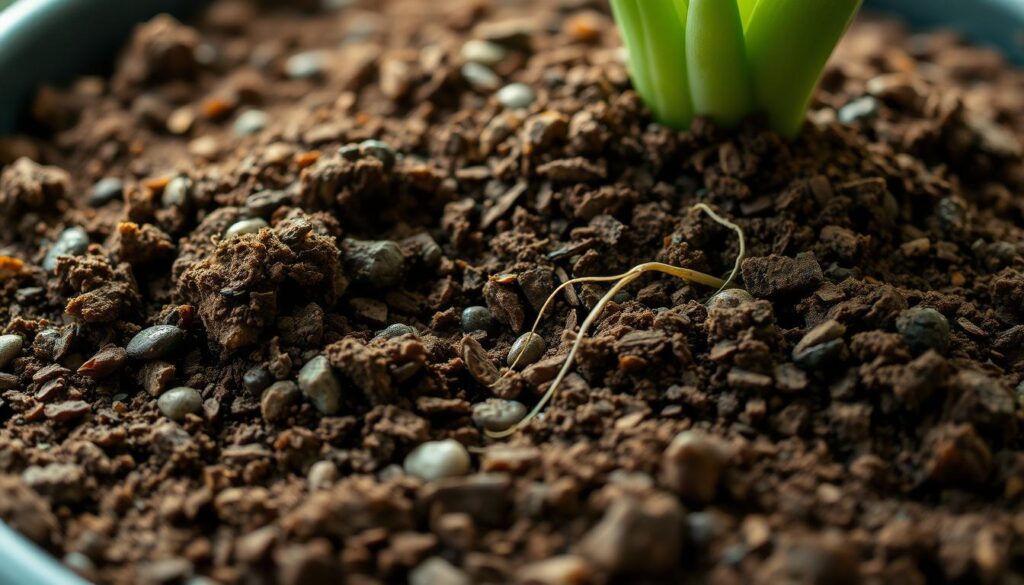
By using the right dracaena plant soil and following proper dracaena plant fertilization techniques, you can create a healthy and thriving environment for your plant. Remember to monitor your plant’s response to the soil mix and adjust as needed to ensure optimal growth.
| Soil Mix Component | Ratio | Benefits |
|---|---|---|
| Loam | 1 part | Provides nutrients and structure |
| Pumice or Perlite | 1 part | Enhances drainage and prevents waterlogging |
| Peat Moss or Pine Fines | 1 part | Retains moisture and maintains acidity |
Watering Guidelines for Dracaena
When it comes to dracaena plant watering, it’s essential to find the right balance. Dracaena plants prefer moist soil, but overwatering can be detrimental to their health. To ensure proper dracaena plant care, it’s crucial to water them carefully, allowing the soil to dry slightly between waterings.
A good rule of thumb is to check the soil moisture by inserting your finger into the soil up to the second knuckle. If the soil feels dry, it’s time to water. The potting medium should be approximately 75% dry before watering again. This will help prevent overwatering, which can lead to root rot and other issues.
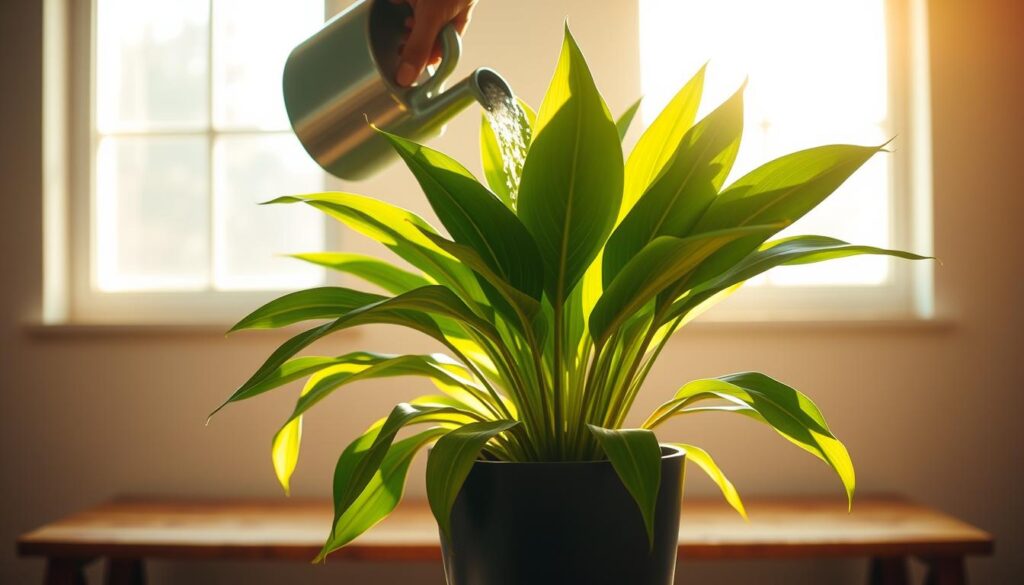
Some key signs of overwatering include brown leaves and tips, as well as yellowing leaves. If you notice these symptoms, it’s essential to adjust your watering schedule accordingly. On the other hand, underwatering can cause leaves to become dry and crispy, leading to wilting and drooping. To avoid these issues, it’s recommended to use a moisture meter to accurately gauge the need for watering.
How Often to Water
Watering frequency should not rely on a set schedule, but instead be guided by soil moisture assessment techniques. In general, it’s recommended to water your dracaena plant when the top 1-2 inches of soil feel dry to the touch. During the winter months, you can reduce watering to every other week or once a month, allowing the top 50% of soil to dry out.
Signs of Overwatering and Underwatering
Being able to identify the signs of overwatering and underwatering is crucial for proper dracaena plant care. Some common signs of overwatering include:
- Brown leaves and tips
- Yellowing leaves
- Root rot
On the other hand, signs of underwatering include:
- Dry and crispy leaves
- Wilting and drooping
By being aware of these signs, you can adjust your watering schedule to ensure your dracaena plant receives the right amount of moisture.
Fertilizing Your Dracaena Plant
As you continue to care for your dracaena plant, fertilization is an essential step to promote healthy growth and development. Dracaena plant fertilization should be done regularly, especially during the growing season. A balanced, water-soluble fertilizer is recommended for dracaena plant care.
Types of Fertilizers
When it comes to choosing a fertilizer for your dracaena plant, it’s best to opt for a balanced plant food with a ratio of 10-10-10 or similar. This type of fertilizer provides the necessary nutrients for your plant to thrive. Some examples of fertilizers include Schultz 10-15-10 Plant Food Fertilizer, which contains 10% nitrogen, 15% phosphorus, and 10% potassium.
When and How to Fertilize
The frequency of fertilization for your dracaena plant can vary depending on the time of year and the plant’s growth stage. During the active growth period (spring and summer), fertilize every 4 to 6 weeks. In the dormant season (fall and winter), fertilize once every 2 months. It’s also important to note that dracaena plants are considered low feeders, so they require minimal fertilization compared to other houseplants.
Here are some tips to keep in mind when fertilizing your dracaena plant:
- Fertilize in high light conditions every 2 months
- Fertilize in medium light conditions four times a year
- Fertilize in low light conditions once or twice a year
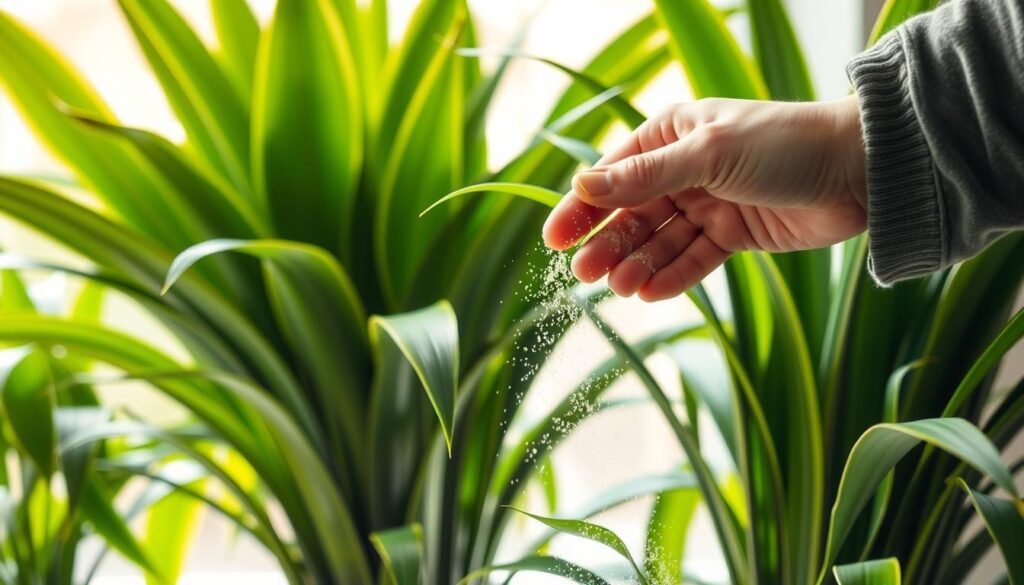
By following these guidelines and using the right type of fertilizer, you can provide your dracaena plant with the necessary nutrients to thrive. Remember to always follow the instructions on the fertilizer package and avoid over-fertilization, which can lead to nutrient toxicity or fertilizer burn.
| Fertilization Frequency | Light Conditions |
|---|---|
| Every 2 months | High light |
| Four times a year | Medium light |
| Once or twice a year | Low light |
Pruning and Trimming Dracaena
Pruning is an essential part of dracaena plant care, as it helps maintain the plant’s shape, promotes healthy growth, and encourages new foliage. Regular dracaena plant pruning can also prevent the plant from becoming leggy and encourage a fuller, more balanced appearance.
To prune your dracaena effectively, it’s best to do so during the active growing season, which typically occurs in spring and summer. Avoid pruning in autumn and winter when the plant is dormant, as this can cause stress and potentially harm the plant. When pruning, remove any dead or damaged leaves and stems, and cut back overgrown stems to maintain the desired shape.
Here are some tips for pruning your dracaena:
- Cut stems at a 45-degree angle to reduce the area vulnerable to bugs, dust, and pathogens.
- Remove between one-quarter and three-quarters of the total stem length for mature specimens.
- Avoid pruning too much of the plant at once, as this can cause stress and lead to disease or pest problems.
By following these tips and incorporating regular dracaena plant pruning into your dracaena plant care routine, you can help keep your plant healthy, thriving, and looking its best.
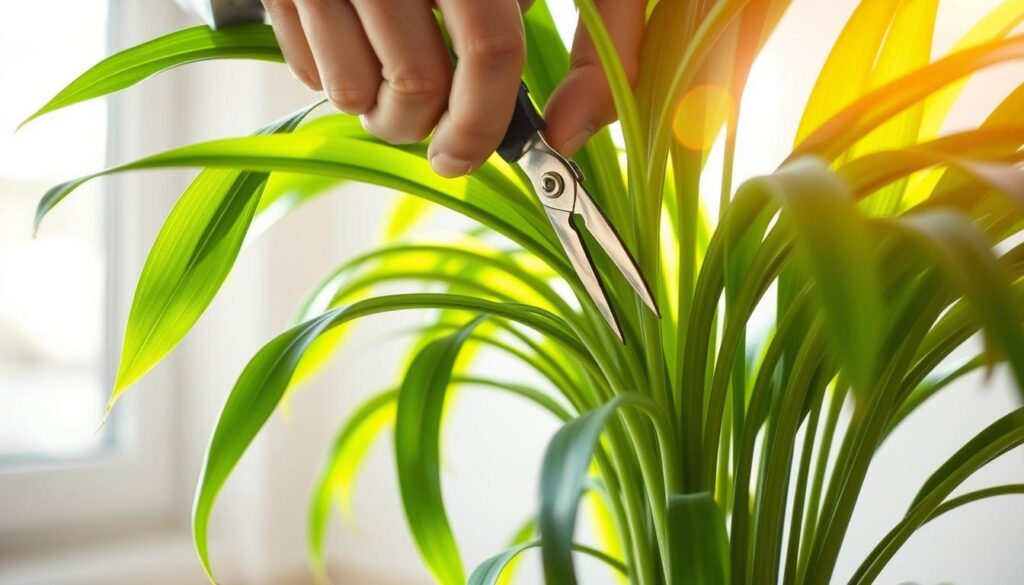
| Pruning Tips | Benefits |
|---|---|
| Prune during active growing season | Promotes healthy growth and encourages new foliage |
| Remove dead or damaged leaves and stems | Prevents the spread of disease and encourages healthy growth |
| Cut stems at a 45-degree angle | Reduces the area vulnerable to bugs, dust, and pathogens |
Common Pests Affecting Dracaena Plants
As you care for your dracaena plant, it’s essential to be aware of common pests that can affect its health. Dracaena plant pests, such as spider mites, mealybugs, and scale, can weaken your plant and affect its growth. Regular monitoring and natural pest control solutions can help prevent infestations and ensure your dracaena plant care is effective.
Some common signs of pest infestations include small brown or yellow specks on leaves, white, cottony clusters, or sticky residue on surfaces. It’s crucial to inspect your plant regularly, checking the tops and undersides of leaves, to catch pest problems early.
Identifying Common Pests
Dracaena plant pests can be challenging to identify, but knowing what to look for can help. Spider mites, for example, can cause premature leaf drop and decline in plant health. Mealybugs can create white, cottony clusters on the plant, while scale insects can produce sticky residue.
Natural Pest Control Solutions
To manage dracaena plant pests, you can use natural pest control solutions such as 70% isopropyl alcohol or neem oil. Insecticidal soap can also be effective, but it’s essential to apply it directly to the pests. Increasing humidity levels and rotating your dracaena plant periodically can also help reduce stress-related pest issues.
By being aware of common pests and taking preventive measures, you can ensure your dracaena plant care is effective and your plant remains healthy. Remember to inspect your plant regularly and use natural pest control solutions to manage any infestations that may occur.
Diseases and Fungal Issues in Dracaena
As you continue to care for your dracaena plant, it’s essential to be aware of potential diseases and fungal issues that can affect its health. Regular monitoring and prompt treatment can help prevent the spread of disease, ensuring your dracaena plant care routine is effective.
Some common dracaena plant diseases include root rot, leaf spot, and fusarium leaf spot. These diseases can be caused by overwatering, poor drainage, or exposure to fungi. It’s crucial to recognize the symptoms of these diseases, such as yellowing leaves, blackened lesions, or soft, mushy areas on the plant.
To prevent dracaena plant diseases, make sure to provide your plant with proper care, including adequate watering, fertilization, and pruning. Here are some tips to keep in mind:
- Water your dracaena plant carefully, avoiding overwatering, which can lead to root rot and other diseases.
- Provide your plant with well-draining soil and a pot with good drainage holes to prevent waterlogged soil.
- Keep your plant in a location with bright, indirect light, avoiding direct sunlight, which can cause leaf scorch.
By following these tips and being mindful of potential diseases, you can help keep your dracaena plant healthy and thriving. Remember, proper dracaena plant care is key to preventing diseases and ensuring your plant continues to grow and flourish.
| Disease | Symptoms | Cause |
|---|---|---|
| Root Rot | Soft, mushy areas on the plant | Overwatering, poor drainage |
| Leaf Spot | Blackened or yellowing leaves | Fungal infection, overwatering |
| Fusarium Leaf Spot | Reddish or tan spots with yellow halos | Fungal infection, poor air circulation |
Propagating Dracaena Plants
Dracaena plant propagation is a great way to share plants with friends or expand your own collection. You can propagate Dracaena plants through stem cuttings, division, or seed. The best method of propagation depends on the species and desired outcome. For example, stem cuttings are a popular method for propagating Dracaena plants, as they are relatively easy to root and can be done at any time of the year.
When it comes to dracaena plant care, propagation is an important aspect to consider. With the right techniques and conditions, you can successfully propagate your Dracaena plant and enjoy its beautiful foliage. Here are some key things to keep in mind when propagating Dracaena plants:
Methods of Propagation
- Stem cuttings: This is a popular method for propagating Dracaena plants. Simply cut the top 4-6 inches of the cane, remove lower leaves, and plant in well-draining soil or water.
- Division: This method involves dividing the roots of a mature plant to create new plants. It’s a bit more challenging than stem cuttings but can be effective.
- Seed: This method is not as common, as Dracaena seeds can be difficult to find and may not produce plants that are true to the parent plant.
Timing and Best Practices
The best time to propagate Dracaena plants is during the spring and summer months when the plant is actively growing. Keep the soil warm, between 70-80°F (21-27°C), and ensure it’s well-draining to prevent rot. With proper care and conditions, you can successfully propagate your Dracaena plant and enjoy its beautiful foliage.
By following these tips and techniques, you can master dracaena plant propagation and dracaena plant care, and enjoy the many benefits of having these beautiful plants in your home or office.
| Method | Rooting Time | Success Rate |
|---|---|---|
| Stem Cuttings | 4-8 weeks | High |
| Division | 1-3 months | Moderate |
| Seed | 2-6 months | Low |
Potting and Repotting Dracaena
As you continue to care for your dracaena plant, you’ll eventually need to consider repotting it. Dracaena plant potting is an essential part of dracaena plant care, as it allows the plant to grow and thrive. Typically, dracaena plants need to be repotted every 2-3 years as they outgrow their containers.
A well-draining potting mix and a slightly larger pot are recommended for repotting. The ideal time to repot dracaena is in the spring before new growth starts, optimizing the plant’s energy use during the upcoming growing season. You can determine if your dracaena needs repotting by looking for signs such as roots emerging from the drainage holes, the plant being top-heavy or unstable, or droopy leaves despite regular watering.
Here are some tips to keep in mind when repotting your dracaena:
- Choose a pot that is 1-2 inches larger than the current container.
- Use a well-draining potting mix to prevent waterlogged soil.
- Repot in the spring or summer, avoiding winter months when the plant is dormant.
By following these tips and considering the specific needs of your dracaena, you can ensure that your plant continues to thrive and grow. Remember to monitor your plant’s condition and adjust your care routine as needed to provide the best possible dracaena plant care.
| Repotting Frequency | Recommended Pot Size | Best Time to Repot |
|---|---|---|
| Every 2-3 years | 1-2 inches larger than current container | Spring or summer |
Conclusion and Final Tips for Dracaena Care
As you’ve learned, caring for a Dracaena plant requires a bit of attention, but the rewards are well worth it. By following the key dracaena plant care and dracaena plant maintenance guidelines outlined in this article, you can help your Dracaena thrive and become a beautiful addition to your indoor space. Remember to provide the right lighting, water when the soil is partially dry, and fertilize periodically during the growing season.
If you encounter any issues with your Dracaena, such as yellowing leaves or pests, don’t hesitate to address them promptly. With a little patience and the right techniques, you can keep your Dracaena healthy and vibrant for years to come. So, embrace your green thumb, and enjoy the air-purifying benefits and visual appeal of this versatile houseplant.
FAQ
What are the different varieties of Dracaena plants?
There are over 170 species of Dracaena plants, including the popular Dracaena Marginata, Dracaena Fragrans, and Dracaena Deremensis varieties.
What are the benefits of having a Dracaena plant indoors?
Dracaena plants can improve indoor air quality by removing harmful toxins and cleaning the air. They also add a touch of tropical elegance to any indoor space.
What are the ideal light requirements for a Dracaena plant?
Dracaena plants thrive in bright, indirect light. They can tolerate low-light conditions but may lose their vibrant color and become leggy.
How do I choose the right pot for my Dracaena plant?
When selecting a pot for your Dracaena, consider the size, material, and drainage. The pot should be slightly larger than the plant’s root system and have adequate drainage holes to prevent overwatering.
What type of soil is best for a Dracaena plant?
Dracaena plants prefer a well-draining, nutrient-rich potting mix. A blend of peat moss, perlite, and compost or coconut coir can provide the ideal soil conditions.
How often should I water my Dracaena plant?
The watering frequency for Dracaena plants depends on factors like the plant’s size, the soil type, and the environmental conditions. As a general rule, allow the soil to partially dry out between waterings and avoid letting the plant sit in water.
What type of fertilizer should I use for my Dracaena plant?
Dracaena plants benefit from a balanced, water-soluble fertilizer applied every 2-3 months during the growing season. Avoid over-fertilizing, as this can lead to problems.
How do I prune and trim my Dracaena plant?
Pruning and trimming your Dracaena can help maintain its shape and encourage new growth. Use clean, sharp scissors or pruners to remove any dead or damaged leaves or stems.
What are the common pests that affect Dracaena plants?
Dracaena plants can be susceptible to pests like spider mites, mealybugs, and scale insects. Using natural pest control methods can help prevent and manage infestations.
How do I propagate my Dracaena plant?
Dracaena plants can be propagated through stem cuttings or air layering. Choose healthy, mature stems and follow the appropriate propagation techniques for the best results.
Source Links
- How to Grow and Care For Dracaena – https://miraclegro.com/en-us/indoor-gardening/how-to-grow-care-for-dracaena.html?srsltid=AfmBOor3Hp1NJkNbamW58irfoAy_MhPMqeNnGK7Cz12xNnXDgtp2kmbO
- How to Care for a Dracaena – https://www.thesill.com/blogs/plants-101/how-to-care-for-a-dracaena?srsltid=AfmBOop49g2Ske34SEBR7rKqslsIEyyTWwEDmPB0PFLK43E_oKzGdnkP
- This Tropical, Evergreen Shrub Will Add Long-Lasting Greenery to Your Home – https://www.thespruce.com/dracaena-overview-care-1902754
- Dracaena (plant) – https://en.wikipedia.org/wiki/Dracaena_(plant)
- North Carolina Extension Gardener Plant Toolbox – https://plants.ces.ncsu.edu/plants/dracaena/
- Dracaena Growing Guide: How to Care for Dracaena Plants – Garden Design – https://www.gardendesign.com/plants/dracaena.html
- How to Grow Dracaena as a Houseplant to Add Life to Any Room – https://www.bhg.com/gardening/plant-dictionary/houseplant/dracaena/
- How to Grow and Care For Dracaena – https://miraclegro.com/en-us/indoor-gardening/how-to-grow-care-for-dracaena.html?srsltid=AfmBOorBEahV8Gje3uxP0-PMjkrS5627bZ5n7p0FROhw81SNlm-GBhcB
- Revitalize Your Dracaena: Master the Art of Repotting – https://be.green/en/blog/revitalize-your-dracaena-master-the-art-of-repotting?srsltid=AfmBOoojgF6v1_Xubvhit5K8wAW7FXZwSTq3umYJWCn1c5Mh_8l_u76X
- How to Grow Dracaena as a House Plant – https://gardengoodsdirect.com/blogs/plant-guide/how-to-grow-dracaena-as-a-house-plant?srsltid=AfmBOorio93aEz7uXSRQa_Kh7fzIeiAgX5YM8pHw-Fvw2YKszbQng02b
- Cafe Planta – https://cafeplanta.com/a/blog/the-best-pot-for-dracaena-a-comprehensive-guide
- Best Soil Potting Mix for Dracaena marginata ‘Bicolor’ – https://greg.app/dracaena-marginata-bicolor-soil/
- How to Grow and Care For Dracaena – https://miraclegro.com/en-us/indoor-gardening/how-to-grow-care-for-dracaena.html?srsltid=AfmBOorGe3X_DI12HFewkMRnU73px7zOZ-LRm3Qvb_pVJCH7EyewMkdr
- Dracaena Repotting: How To Repot A Large Dracaena Lisa – https://www.joyusgarden.com/dracaena-repotting-how-to-repot-a-large-dracaena-lisa/
- How to Water Dracaena Plants | Gardener’s Path – https://gardenerspath.com/plants/houseplants/water-dracaena/
- Essential Tips for Watering Dracaena Marginata | HRC – https://houseplantresourcecenter.com/2023/02/essential-tips-for-watering-dracaena-marginata/
- Feeding A Dracaena – How To Fertilize Dracaena Plants – https://www.gardeningknowhow.com/houseplants/dracaena/how-to-fertilize-dracaena-plants.htm
- How to Fertilize Dracaena | Step-By-Step Guide (With Pictures and Video) – https://tenneyplants.com/how-to-fertilize-dracaena/
- The Best Fertilizer For Dracaenas — Plant Care Tips and More · La Résidence – https://blog.leonandgeorge.com/posts/best-fertilizer-dracaenas
- Dracaena care: watering, pruning & more – Plantura – https://plantura.garden/uk/houseplants/dracaena/dracaena-care
- When and How to Prune Dracaena | Gardener’s Path – https://gardenerspath.com/plants/houseplants/prune-dracaena/
- Dracaena Pest Control – Learn About Bugs That Eat Dracaena Plants – https://www.gardeningknowhow.com/houseplants/dracaena/dracaena-pest-control.htm
- Common Compact Dracaena Pests (And What To Do About Them) – https://cafeplanta.com/blogs/resources/compact-dracaena-pests
- Common Dracaena Problems – What’s Wrong With My Dracaena Plant – https://www.gardeningknowhow.com/houseplants/dracaena/common-dracaena-problems.htm
- How to Identify and Treat 9 Dracaena Diseases | Gardener’s Path – https://gardenerspath.com/plants/houseplants/dracaena-diseases/
- Want More Dracaenas in Your Home? How to Propagate One Like a Pro – https://www.thespruce.com/how-to-propagate-a-dracaena-8546306
- Easy Ways to Propagate Dracaena Houseplants | HRC – https://houseplantresourcecenter.com/2022/08/easy-ways-to-propagate-dracaena-houseplants/
- Repotting Dracaena | A Step-by-Step Guide | HRC – https://houseplantresourcecenter.com/2023/03/repotting-dracaena-a-step-by-step-guide/
- Revitalize Your Dracaena: Master the Art of Repotting – https://be.green/en/blog/revitalize-your-dracaena-master-the-art-of-repotting?srsltid=AfmBOorZcCjBKbCwCLXPyvBUeu9Mg3b2FAloehLivXGzD59XwOqTJh7s
- How to Care for a Dracaena – https://www.thesill.com/blogs/plants-101/how-to-care-for-a-dracaena?srsltid=AfmBOoqK5fNBs68XrtkjU1J8NRZQAWgk_g_8UMWIAuVgUAmSjrhFMkKz
- Dracaena Care Guide – https://www.livelyroot.com/blogs/plant-care/dracaena-care-guide?srsltid=AfmBOopWfOwFq_3dUUwpgoIsWVqFcPL_jleqcRSDgIYGPc0G_3d-4cBK

